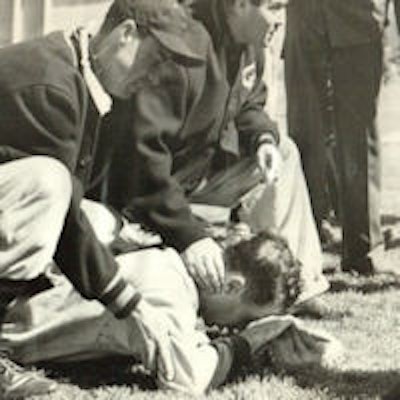
Baseball catcher Joe Sprinz "staggered a few steps, as he grasped his mouth with both hands. He fell forward and writhed in agony as his teammates rushed toward him." The description by Harry Borba, a sportswriter for the San Francisco Examiner, was describing a publicity stunt in 1939 that coincided with the 100th anniversary of baseball. "When he fell, face forward, a muffled groan [from the crowd] went up," Borba continued.
 In August 1939, baseball catcher Joe Sprinz's attempted to set the world record for catching a baseball dropped from the highest height ever -- 800 feet.
In August 1939, baseball catcher Joe Sprinz's attempted to set the world record for catching a baseball dropped from the highest height ever -- 800 feet.
A few days earlier, Lefty O'Doul, the manager of the Pacific Coast League's (PCL) San Francisco Seals, had announced that Sprinz would attempt to establish the world record for catching a baseball dropped from the highest height ever -- 800 feet. It would occur during a baseball game before a crowd of 15,000. Coincidently it was Sprinz's 37th birthday too.
In 1939, the Pacific Coast League was almost the West Coast version of the American and National Baseball Leagues -- neither of which had representative teams out west. Major stars who developed in the PCL include Joe DiMaggio and Ted Williams. The league went into decline when the Brooklyn Dodgers moved to Los Angeles and the New York Giants to San Francisco, and lives today as a Triple-A league with teams from the Midwest to the West Coast.
Five balls were to be dropped from the Goodyear blimp hovering overhead. The balls were scheduled to be dropped during festivities at a nonleague game on San Francisco's Treasure Island, then hosting the world's fair -- the Golden Gate International Exhibition.
Sprinz missed the first four balls. But on the fifth, the blimp's captain, A. J. Sewell (an ace bomber pilot during World War I), said he "thought that Sprinz had it." He added, "From the ship [blimp] it looked as if it hit his glove first. ... He walked quite a ways and then sat down. Then some persons crowded around him and we saw him lying down."
 Sprinz knocked out eight teeth, fractured his upper jaw, broke his nose, and severely lacerated both lips.
Sprinz knocked out eight teeth, fractured his upper jaw, broke his nose, and severely lacerated both lips.
A University of California mathematician calculated the ball was traveling at 145 miles an hour when Sprinz made his catch. "Few realized just how close Joe Sprinz stood to death in that fleeting split of a second when the ball crashed through his upraised hands," Borba wrote.
The force of the ball gathered as it descended from the blimp, tearing Sprinz's hands apart, allowing the ball to crash against his face. Even today, 75 years later, the physicist David Halliday uses the event as an example of terminal velocity in his physics textbook The Fundamentals of Physics.
Charley Graham, president of the Seals, "saw the whole thing perfectly." He told a local reporter: "The ball came down true and Joe was right under it. He gauged it perfectly but he attempted to catch the ball over his face like he catches fairly high foul flies." The ball, according to Graham, "had too much force hitting him on the mouth." Graham went on to opine that Sprinz should have tried to catch the ball "out in front of him," acknowledging the sun and wind interfered with his historic catch.
“Suddenly realizing the danger he had put his star catcher in, O'Doul ran out onto the field to recall Sprinz, but 'it was a bit too late' he said, continuing 'he was down, the damage done.' ”
The ball slammed into Sprinz's face, knocking out eight teeth, fracturing his upper jaw, breaking his nose, and severely lacerating both lips. O'Doul told reporters he couldn't see the balls as they dropped to the earth until "they were really close to the ground ... then they looked like aspirin tablets."
Suddenly realizing the danger he had put his star catcher in, O'Doul ran out onto the field to recall Sprinz, but "it was a bit too late," he said, continuing "he was down, the damage done."
The following day, Sprinz "murmured" through his hospital bandages and a wired jaw reflecting on what happened: "I had the ball judged all the way. The ball hit my glove. ... [It] didn't hit my face. The jar of the ball drove the mitt back against my mouth and caused all the damage."
"Most of the eight teeth lost were bridgework and can be replaced," his doctor noted. Sprinz chimed in that he was more hurt and baffled by his failure to hold onto the ball "than he is hurt by his hurts." He returned the following year in May 1940 as the starting catcher for the Seals, claiming he was "just as good" as he was before the accident.
After his retirement from baseball in 1942, he worked with the Seals back office and later with little leagues and the San Francisco Parks and Recreation Department, developing intercity baseball. Sprinz died in 1977 in San Francisco. He was 91.
Sprinz's catch was officially recorded in the Guinness Book of World Records as the World's Highest Catch in 1994.
In 2012 and 2013, baseball sportswriter Zack Hample decided to break Sprinz's record. He accomplished the feat in July 2013, catching a baseball dropped from a helicopter dropped from 1,050 feet. Unlike Sprinz -- and maybe because of him -- Hample wore protective gear, including a catcher's mask, hard-shell protective headgear, and breast plate. Nobody from the Guiness World Record organization attended, although invited. Hample lost no teeth. Officially, Sprinz still holds the record.
Daniel Demers is a semiretired businessman whose hobby is researching and writing about 19th and 20th century historical events and personalities. He holds a bachelor's degree in history from George Washington University and a master's degree in business from Chapman University. You can review his other published works at www.danieldemers.com.
The comments and observations expressed herein do not necessarily reflect the opinions of DrBicuspid.com, nor should they be construed as an endorsement or admonishment of any particular idea, vendor, or organization.
Sources
Books
Halliday D, Resnick R, Walker J. Motion along a straight line. Fundamentals of Physics. 4th ed. New York, NY: Wiley and Sons, 1993:30.
Articles
Borba H. Seal catcher hit in face with ball dropped by blimp. San Francisco Examiner. August 4, 1939.
Flight of Ball Okeh from Blimp, San Francisco Examiner. August 4, 1939.
Just 10 minutes before attempting catch. San Francisco Examiner. August 5, 1939.
Lefty O'Doul, batting champion with Phillies and Dodgers, dies. New York Times. December 8, 1969.
Poor Joe -- He's resting easy. San Francisco Chronicle. August 5, 1939.
Scouts enjoy day. San Francisco Chronicle. August 4, 1939.
Sprinz O.K.; fear of falling pellets vanishes. San Francisco Examiner. March 14, 1940.
This ends any stunts for seals, Charley Graham says. San Francisco Examiner. August 4, 1939.
Websites
Charley Graham. Wikipedia website. https://en.wikipedia.org/wiki/Charlie_Graham. Accessed November 20, 2013.
Golden Gate International Exhibition. Wikipedia website. https://en.wikipedia.org/wiki/Golden_Gate_International_Exposition. Accessed November 20, 2013.
Joe Sprinz. Wikipedia website. https://en.wikipedia.org/wiki/Joe_Sprinz. Accessed November 20, 2013.
Lefty O'Doul. Wikipedia website. https://en.wikipedia.org/wiki/Lefty_O%27Doul. Accessed November 20, 2013.
Pacific Coast League. Wikipedia website. https://en.wikipedia.org/wiki/Pacific_Coast_League. Accessed November 20, 2013.
Who caught the highest pop up ever? Modern Spectator. Accessed November 21, 2013.
Zack Hample's helicopter drop catch. Yahoo Sport's Minute. Accessed November 20, 2013.
Email correspondence
Sarah Wilcox, Guinness Book of World Records, February 6, 2012.















